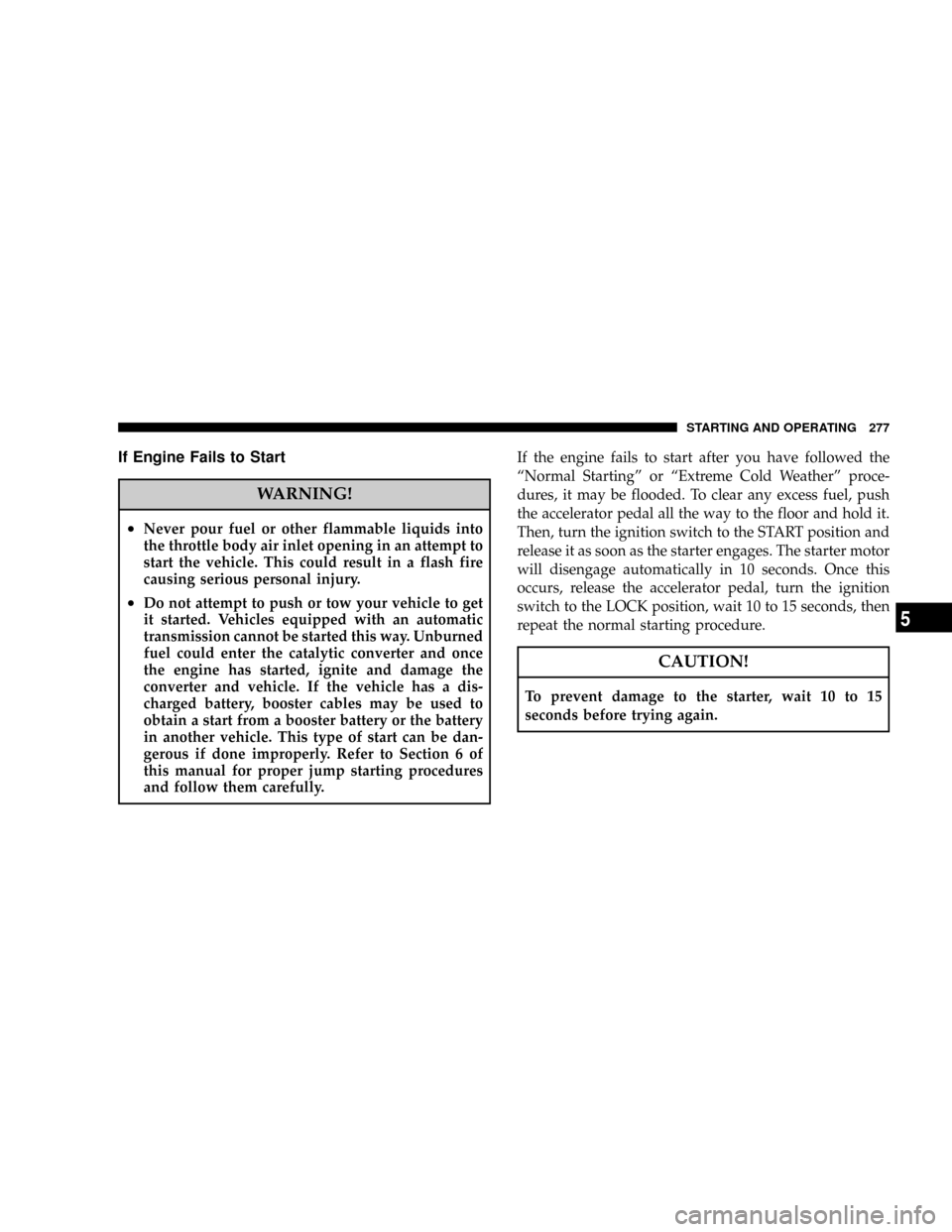Page 202 of 490
²Service Distance
²Display Units of Measure in
Press the SCROLL button to cycle through all the Trip
Computer functions.
The Trip Functions mode displays the following informa-
tion:
²Average Fuel Economy / Fuel Saver Mode (5.7L
Engine Only)
Shows the average fuel economy since the last reset.
When the fuel economy is reset, the display will read
ªRESETº or show dashes for two seconds. Then, the
history information will be erased, and the averaging will
continue from the last fuel average reading before the
reset.Vehicles with the 5.7L Multi-Displacement System (MDS)
are equipped with the FUEL SAVER MODE in the Trip
Functions of the EVIC. The FUEL SAVER message will
display above the average fuel economy in the EVIC
display. This message will appear whenever MDS allows
the engine to operate on four cylinders, which will vary
depending on driving habits and vehicle usage.
4 Cylinder Operation - MDS On
202 UNDERSTANDING YOUR INSTRUMENT PANEL
Page 203 of 490

This feature allows you to monitor when the MDS
switches off the fuel on four of the eight cylinders and it
can be used to modify driving habits in order to increase
the time in which the fuel saver mode is active.²Distance To Empty (DTE)
Shows the estimated distance that can be traveled with
the fuel remaining in the tank. This estimated distance is
determined by a weighted average of the instantaneous
and average fuel economy, according to the current fuel
tank level. DTE cannot be reset through the FUNCTION
SELECT button.
NOTE:Significant changes in driving style or vehicle
loading will greatly affect the actual drivable distance of
the vehicle, regardless of the DTE displayed value.
²When the DTE value is less than 30 miles (48 km)
estimated driving distance, the DTE display will
change to a text display of9LOW FUEL.9This display
will continue until the vehicle runs out of fuel. Adding
a significant amount of fuel to the vehicle will turn off
the9LOW FUEL9text and a new DTE value will
display.
8 Cylinder Operation - MDS Off
UNDERSTANDING YOUR INSTRUMENT PANEL 203
4
Page 261 of 490

located on the control panel. Conditioned air will be
directed through the outlets selected by the mode control.
A light in the snowflake button shows that the air
conditioning is on.
Slight changes in engine speed or power may be noticed
when the air conditioning compressor is on. This is a
normal occurrence as the compressor will cycle on and
off to maintain comfort and increase fuel economy.
Automatic Temperature Control Ð If Equipped
The Infrared Dual-Zone Climate Control System auto-
matically maintains the interior comfort level desired by
the driver and passenger. This is accomplished by a dual
sun-sensor in the top of the instrument panel, and an
infrared sensor located in the face of the control unit.
There are also various sensors monitored by this system
which take account for vehicle speed, A/C pressure,
outside temperature, and engine cooling temperature.
The infrared sensor independently measures the surfacetemperature of the driver and passenger. Based on the
sensor input, the system automatically adjusts the air
flow temperature, the air flow volume, and amount of
outside air recirculation. This maintains a comfortable
temperature even under changing conditions.
Automatic Temperature Controls
UNDERSTANDING YOUR INSTRUMENT PANEL 261
4
Page 273 of 490

NTire Spinning........................321
NTread Wear Indicators..................322
NLife Of Tire.........................323
NReplacement Tires.....................323
NAlignment And Balance.................324
mTire Chains...........................325
mTire Rotation Recommendations............325
mTire Pressure Monitor System (TPMS)........326
NBase System Ð If Equipped..............329
NPremium System Ð If Equipped..........331
NGeneral Information...................336
mFuel Requirements......................336
N3.7/4.7L Engines (If Equipped)............336N5.7L Engines (If Equipped)...............337
NReformulated Gasoline.................337
NGasoline/Oxygenate Blends..............338
NMMT In Gasoline.....................338
NMaterials Added To Fuel................339
NFuel System Cautions..................339
NCarbon Monoxide Warnings..............340
mFlexible Fuel (4.7L Engine Only) Ð
If Equipped...........................340
NE-85 General Information................340
NEthanol Fuel (E-85)....................341
NFuel Requirements....................342
NSelection Of Engine Oil For Flexible Fuel
Vehicles (E-85) And Gasoline Vehicles.......343
STARTING AND OPERATING 273
5
Page 274 of 490

NStarting............................343
NCruising Range.......................343
NReplacement Parts.....................343
mFuel Requirements (Diesel Engines)..........344
mAdding Fuel..........................345
NFuel Filler Cap (Gas Cap)...............346
mVehicle Loading........................348
NCertification Label.....................348
mTrailer Towing.........................351
NCommon Towing Definitions.............351
NTrailer Hitch Classification...............354NTrailer Towing Weights (Maximum Trailer
Weight Ratings)......................355
NTrailer And Tongue Weight..............357
NTowing Requirements..................358
NTowing Tips.........................362
mRecreational Towing (Behind Motorhome, Etc.) . . 364
NTowing ± 2WD Models.................364
NTowing Ð Quadra-Trac I (Single-Speed Transfer
Case) 4WD Models....................364
NTowing Ð Quadra±Trac II /Quadra±Drive II
4WD Models........................364
mSnow Plow...........................368
274 STARTING AND OPERATING
Page 277 of 490

If Engine Fails to Start
WARNING!
²Never pour fuel or other flammable liquids into
the throttle body air inlet opening in an attempt to
start the vehicle. This could result in a flash fire
causing serious personal injury.
²Do not attempt to push or tow your vehicle to get
it started. Vehicles equipped with an automatic
transmission cannot be started this way. Unburned
fuel could enter the catalytic converter and once
the engine has started, ignite and damage the
converter and vehicle. If the vehicle has a dis-
charged battery, booster cables may be used to
obtain a start from a booster battery or the battery
in another vehicle. This type of start can be dan-
gerous if done improperly. Refer to Section 6 of
this manual for proper jump starting procedures
and follow them carefully.If the engine fails to start after you have followed the
ªNormal Startingº or ªExtreme Cold Weatherº proce-
dures, it may be flooded. To clear any excess fuel, push
the accelerator pedal all the way to the floor and hold it.
Then, turn the ignition switch to the START position and
release it as soon as the starter engages. The starter motor
will disengage automatically in 10 seconds. Once this
occurs, release the accelerator pedal, turn the ignition
switch to the LOCK position, wait 10 to 15 seconds, then
repeat the normal starting procedure.
CAUTION!
To prevent damage to the starter, wait 10 to 15
seconds before trying again.
STARTING AND OPERATING 277
5
Page 278 of 490
After Starting
The idle speed is controlled automatically and it will
decrease as the engine warms up.
Normal Starting Ð Diesel Engines
Observe the following when the engine is operating.
²All message center lights are off.
²Malfunction Indicator Light (MIL) is off.
²Low Oil Pressure Light is off.
Cold Weather Precautions
Operation in ambient temperature below 32ÉF (0ÉC) may
require special considerations. The following chart sug-
gest these options:
*No. 1 Ultra Low Sulfur Diesel Fuel (ULSD) should only
be used where extended arctic conditions (-10ÉF/-23ÉC)
exist.
278 STARTING AND OPERATING
Page 279 of 490

NOTE:
²Use of Climatized ULSD Diesel Fuel or Number 1
ULSD Diesel Fuel results in a noticeable decrease in
fuel economy.
²Climatized ULSD Diesel Fuel is a blend of Number 2
ULSD and Number 1 ULSD Diesel Fuels which re-
duces the temperature at which wax crystals form in
fuel.
NOTE:This engine requires the use ofªUltra Low
Sulfur Diesel Fuel.ºUse of incorrect fuel could result in
exhaust system damage. Refer to ªFuel Requirementsº in
this section for further details on fuel recommendations.
Battery Blanket Usage
A battery loses 60% of its cranking power as the battery
temperature decreases to 0ÉF (-18ÉC). For the same de-
crease in temperature, the engine requires twice as much
power to crank at the same RPM. The use of 120 VAC
powered battery blankets will greatly increase startingcapability at low temperatures. Suitable battery blankets
are available from your authorized Mopartdealer.
Engine Starting Procedure
WARNING!
NEVER pour fuel or other flammable liquid into the
air inlet opening in an attempt to start the vehicle.
This could result in a flash fire causing serious
personal injury.
1. The gear selector must be in the ªNº (Neutral) or ªPº
(Park) position before you can start the engine.
2. Turn the ignition key to the ON position.
3. Watch for the ªGlow Plug Indicator Lightº in the
instrument cluster. Refer to ªInstrument Clusterº in
Section 4. It will glow for two to ten seconds or more,
STARTING AND OPERATING 279
5